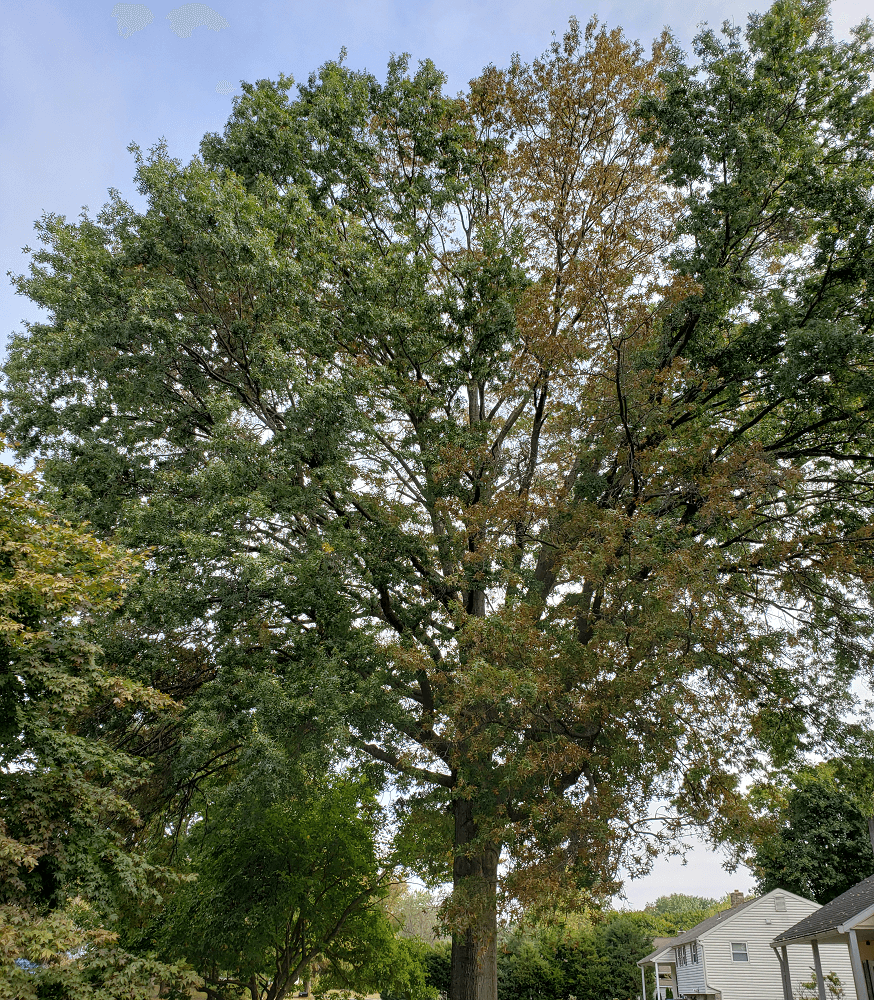Bacterial Leaf Scorch
Bacterial leaf scorch (BLS) is a systemic bacterial infection treated via cultural management practices. Eastern Pennsylvania residents have been dealing with this disease for decades. BLS is widespread in Pennsylvania on pin oaks and red oaks, is known to be spreading toward the state’s western region.
Cause & Spread
BLS is caused mainly by the xylem-plugging bacterium Xylella fastidiosa. The disease invades the xylem, the plant tissue that transports water and nutrients throughout plants, and clogs the tissue. As a result, the condition blocks water movement within a plant. When plants receive inadequate, many problems arise. Although bacteria cause the disease, leafhoppers, treehoppers, and spittlebugs spread BLS to other plants.
Leafhoppers are tiny insects that feed on plants and can carry the bacteria to new areas and then spread the bacteria by feeding on branches or leaves with damaged tissue. Many types of leafhopper exist, and vary in size from 1/16 inch to 2 inches long. Leafhoppers feed on plant juices by sucking them out through their needle-like mouth parts (called stylets). When leafhoppers bite infected plants, the insects inject the bacteria into the host, which multiplies and spreads throughout the plant’s system. Other insects, such as spittlebugs and treehoppers, are also known to carry and transmit the bacteria from plant to plant.
Symptoms of Bacterial Leaf Scorch
The symptoms of this disease typically appear in mid to late summer on lower branches as irregular marginal browning on interior leaves. Symptoms also progress along the branch towards the tip of a plant. The following symptoms characterize BLS:
- Scorched leaves, along with small and large dead areas, usually between the leaf veins
- Yellowing or browning leaves that eventually turn brownish black before falling off the tree prematurely
- Dieback on one side of the trunk starting at ground level which progresses upward after several years
- Stunted growth makes the tree more susceptible to wind damage
Overall, bacterial leaf scorch causes a decline in the plant’s health because fewer nutrients reach the roots.
What Plants Are Susceptible to Bacterial Leaf Scorch?
BLS affects various plants and trees. Some of the tree species which can be affected include the following:
- Pin Oak
- Red Oak
- Red Maple
- Ash
- Elm
- Sycamore
- Mulberry
The bacteria can also infect shrubs and crop species like blackberries and peaches.

Management for Bacterial Leaf Scorch
Despite research about this disease, a cure for bacterial leaf scorch has yet to be developed. Plant health care experts and specialists can minimize the effects of this disease, and the most effective control strategy for bacterial leaf scorch is the use of antibiotic injections.. Here are some practices and methods a plant health care expert can recommend to mitigate the impact of BLS.
Watering
Watering during drought can help reduce the risk of BLS infections. An important note is that when watering plants, water the plant or tree deeply and infrequently rather than providing shallow, more frequent watering sessions.
Pruning
Pruning of infected branches may help reduce the spread of BLS within the crown if the disease is detected early.
Contact Burkholder PHC for A Free Plant Health Care Consultation
Bacterial leaf scorch is a severe tree disease and can cause significant damage to affected plants. If you have plants that show signs of the disease or want to be proactive in keeping your landscape safe, reach out to Burkholder PHC. Our team will conduct a plant health care evaluation and diagnosis of your landscape and inform you of your treatment options. Burkholder PHC provides no-cost identification of the situation. Contact us today for a free consultation.

